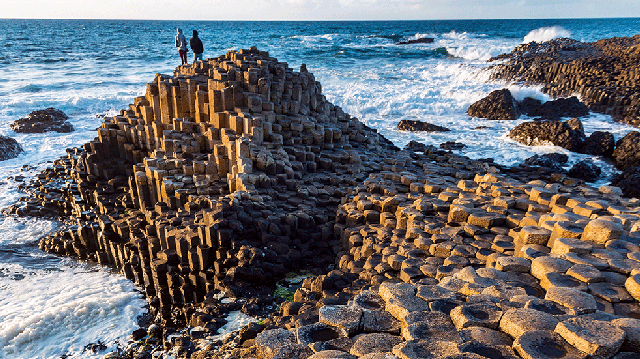
From the Giant’s Causeway to the home of the Titanic, visit Belfast and beyond for a trip combining a city’s history with spectacular coasts
Belfast and the Causeway Coast topped Lonely Planet’s 2018 must-see list, so follow our expert guide to the area: head west to find top-notch pubs, shipwreck tales and one of Europe’s finest scenic drives
In Belfast, the old jokes are still the best. “Round here even the atheists are Catholic atheists or Protestant atheists,” says Billy Scott, taxi driver-turned-tourist guide, as he drives me through the city’s battle-scarred neighbourhoods in his black cab.
Nearly 20 years on from the Good Friday Agreement that brought peace to these streets, the barricade known as the Peace Wall – dividing the loyalist Shankill from the republican Falls Road – is still in place, but the aggressive sectarianism has softened. The Troubles have turned to heritage, just part of the city’s rich and colourful past, and a tour with the likes of Billy Scott – raconteur as well as social historian – is an ideal way to start understanding the spirit of the place.
On the Shankill Road, Billy points out a mural of armed paramilitaries that has been updated by removing their balaclavas to reveal smiling faces. On the Falls Road we pass a brand-new mural declaring that ‘Ireland stands with Catalonia’. “Up until the Peace Agreement this was a tourist wilderness,” says Billy. “But people are naturally interested in the mechanism and resolution of conflict.” There’s no greater illustration of this transition than the infamous Crumlin Road Gaol in north Belfast, which is now a visitor attraction. When Billy says that “Most of our politicians have spent time in there,” he’s not joking for once.
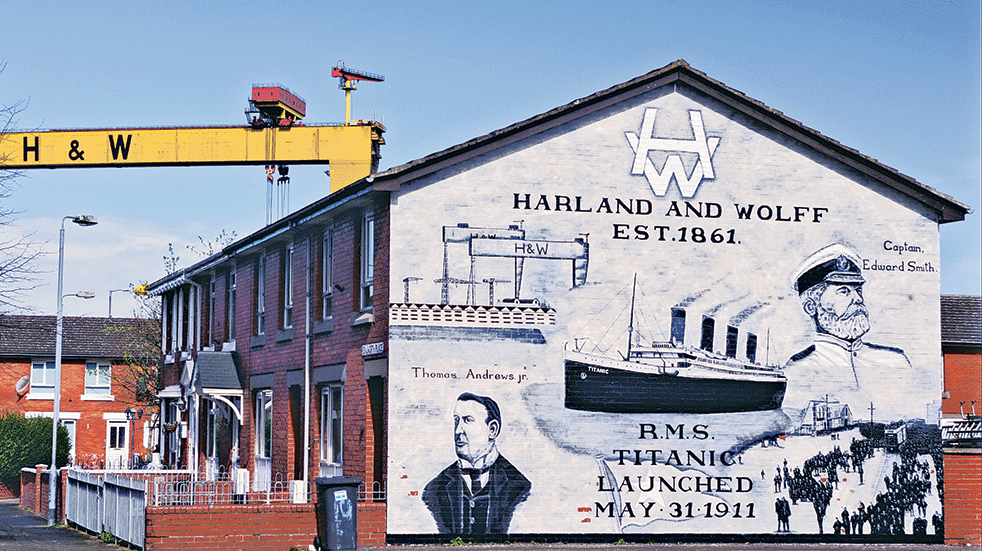
A Titanic history
Belfast, a city of ingenuity and industrial might, has made a habit of turning adversity to its advantage. For decades it didn’t care to be associated with RMS Titanic, the White Star Line’s famous ship that struck an iceberg on its maiden transatlantic voyage in 1912. “It wasn’t one of our success stories – until they made the film,” says Billy, referring to the 1997 blockbuster Titanic directed by James Cameron. The film triggered worldwide interest in this poignant and tragic tale – and Belfast abruptly remembered that the liner had been built here, in the Harland and Wolff shipyards in the east of the city.
The old H&W offices have been ‘repurposed’ as a hotel, where I am staying. Next door is Titanic Belfast, a colossal visitor experience (the word ‘museum’ hardly does it justice), which opened in 2012 and forms the core of a project aimed at regenerating the largely derelict shipyard and dock area, renamed the Titanic Quarter.
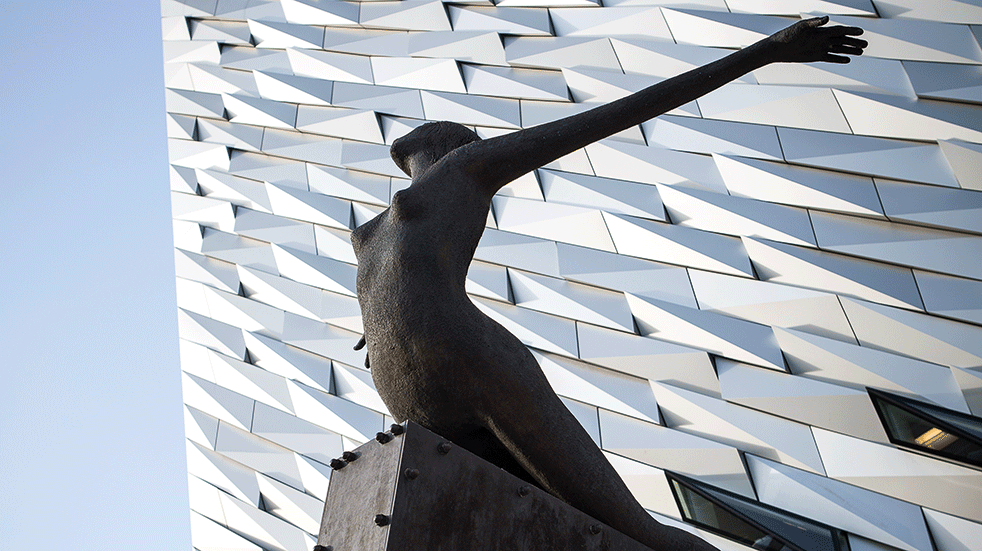
‘Titanoraks,’ as enthusiasts for all things Titanic are known, have boosted visitor numbers to the city – as have fans of Game of Thrones, much of which was filmed along the nearby Causeway Coast in County Antrim. Suddenly the city once synonymous with bullets and bombs is cool – so much so that last October Lonely Planet guides voted Belfast and the Causeway Coast the best region in the world to visit in 2018 (Alaska came second). On my short break – divided between Belfast and the Antrim coast – I’m about to discover what all the fuss is about.
Belfast’s Titanic Quarter
First impressions are misleading. Having checked in to the Titanic Hotel, and walked past the wood-panelled former boardroom and chairman’s office of Harland and Wolff to reach my room, the view from the window is disappointing – a vast expanse of empty concrete planted with lines of vertical steel posts. By the end of my stay, however, my imagination has filled the void with a shimmering ship in the sky. For the concrete in question is the slipway where Titanic was built and first touched water on 31 May, 1911. As dusk falls, lines of blue lights become visible, tracing the outline of the ship. The next morning, I walk (at a steady pace) its invisible length from stern to prow with my stopwatch: it takes 3 minutes, 31 seconds.The ghostly prow finishes where Titanic Belfast begins – a three-pointed steel structure as high as Titanic herself, in which each of the points resembles the jutting prow of a mighty liner or, if you prefer, the terrifying vision of a deadly iceberg. Inside, state-of-the-art installations and techniques recreate the industrial Belfast and noisy shipyards of the early 20th century, Titanic’s triumphant launch, attended by 100,000 people, and the terror of her sinking in the fathomless North Atlantic. The vertigo-inducing 3D ride from Titanic’s boiler rooms to her wheelhouse is particularly effective.
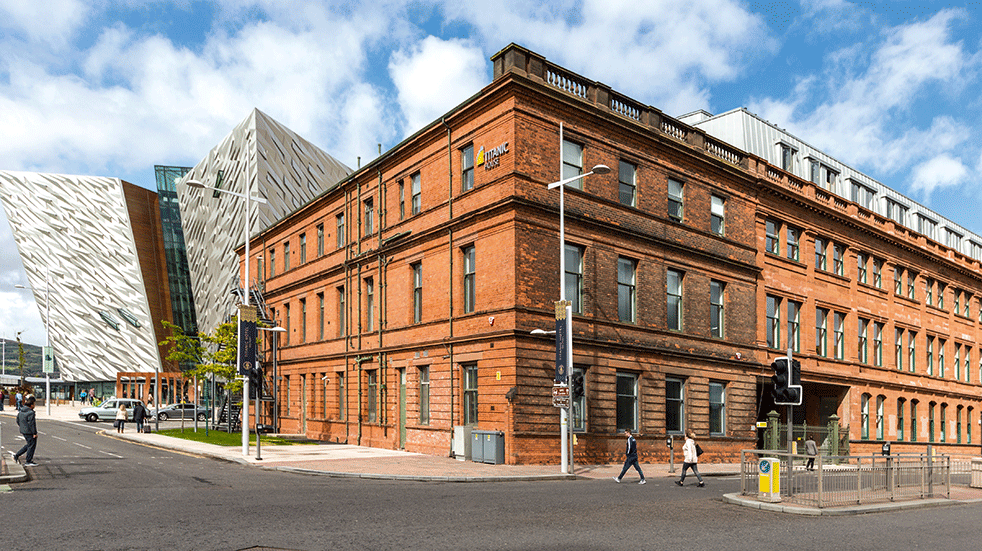
The Belfast city tour
After spending a good morning in the Titanic Quarter, it’s time to launch myself into the Belfast streets that Billy Scott showed me from his cab the day before. I had assumed that the Titanic Quarter would be too far from the city centre to be able to walk there. In fact it is no more than a brisk 20-minute stroll along the Lagan River to the edge of town where my lunch stop awaits, the Michelin-starred Ox restaurant. “The food at Ox is like a flute band marching across your tongue,” Billy Scott had promised me. And my cured sea trout followed by cod in a subtle bisque broth certainly have the taste buds doing a jig. But what also tickles me about Ox are the two elegantly attired ladies who arrive at the same time as me. As I leave, they are still on their Champagne aperitifs. When I walk past Ox again three hours later, they are still there, now cradling glasses of dessert wine.
In between times, I have walked south to the University Quarter and back, warming myself on this cold day by sitting in the curvilinear Palm House in the Botanic Gardens when I get there, and necking a half of stout in the tiled Victorian extravaganza that is the Crown Liquor Saloon on the way back. The goal of this excursion is the Ulster Museum in the Botanic Gardens. Specifically, an exhibit there associated with another maritime disaster that I hope will get me in the mood for tomorrow’s departure for the Causeway Coast.
In October 1588, a ‘galleass’ (a boat with both oars and sails) called Girona – part of the routed Spanish Armada – sank off Lacada Point, just to the east of the Giant’s Causeway. It lay undiscovered until 1967, and its treasures now form a remarkable collection in the Ulster Museum, the most precious pieces being a gold and ruby pendant in the form of a salamander, and a gold pendant with emeralds, amethyst and pearl. I’ve become oddly attached to this story – my plan is to find the place where the Girona went down and reflect on those poor seafarers who perished far from home.
Escape to the coast
The journey out of Belfast the next morning couldn’t be easier, making me reflect that yoking city and coast together on a single trip makes perfect sense (especially when concluded with a flight out of City of Derry Airport at the other end). It takes me five minutes to get on the A2 out of the city. Ten minutes after that the waters of Belfast Lough are practically lapping at my wheels, and for the next 100 miles the Causeway Coastal Route (marked by brown heritage signs) lives up to its reputation as one of the finest scenic drives in Europe.
Except for a stretch over tea-coloured moorland and the ‘Vanishing Lake’ (something to do with a leaky chalk bed) of Loughareema on the approach to Ballycastle, and an inland diversion to Coleraine at one point, the coastal road really does hug the ocean. Those triangular signs warning of falling rocks make frequent roadside appearances and there are dizzying reveals of cliffs and headlands stepping back into the misty distance like reflections in a hall of mirrors.One of the highlights of the route, the old salmon fishermen’s rope bridge that swings 30 metres above the ocean at Carrick-a-Rede, is closed due to high winds. So (feigning regret) I push on to the Giant’s Causeway.
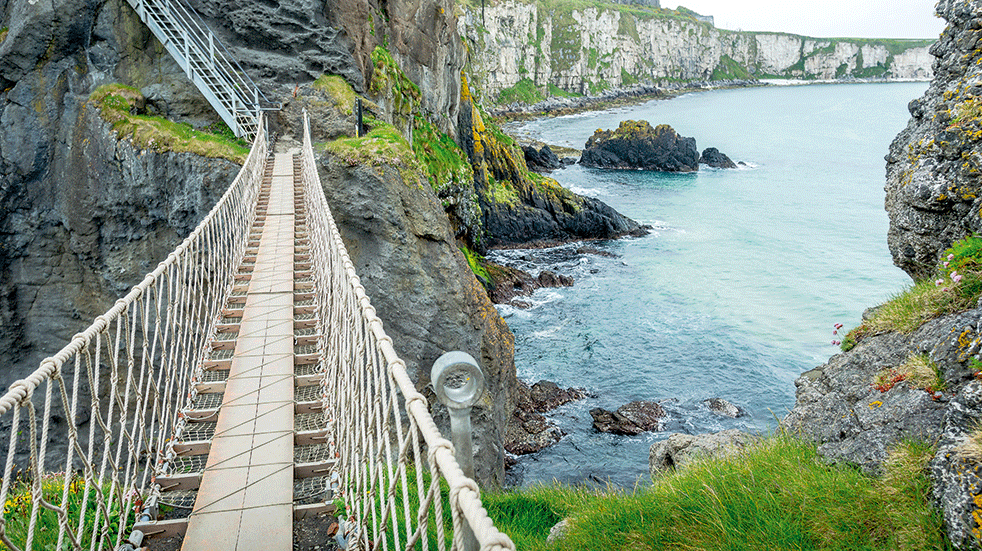
The Giant’s Causeway
The low spit of mostly hexagonal basalt columns has been co-opted into the legend of the Irish giant Finn McCool. Up on the interlocking stones of the Giant’s Causeway, which fit as tightly as the blocks of the Great Pyramids, a National Trust volunteer is just telling me how to get to Lacada Point when he breaks off and points out to sea. “Look! Dolphins jumping. Two, three, no, more – a big pod.” And there they are, turning and turning in the pewter sea.
Pushing east along the cliffs I look back and the Giant’s Causeway has assumed a familiar shape: it’s become a slipway and my mind needs no blue lights to start building a ship on it. Further on at Lacada Point, I gaze down on choppy waters and realise the true object of this exercise. I’m not just thinking of the crew of the Girona but of souls who lie in even deeper, colder waters.
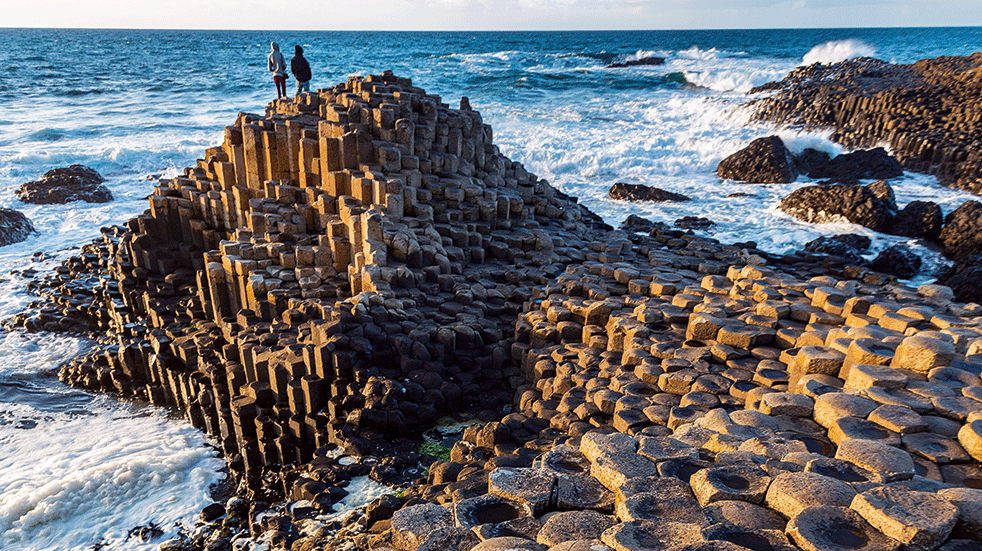
Plan your trip: getting there
Flying: Flybe flies from London City (to Belfast City), Ryanair from London Stansted (to Belfast International), EasyJet from Glasgow and numerous other UK airports (to Belfast International), BA from London Heathrow and Gatwick (to Belfast City). Flybmi flies from Derry to London Stansted, Ryanair from Derry to Glasgow.
Ferries: Stena Line sails from Cairnryan (nr Stranraer) and Liverpool Birkenhead to Belfast; P&O sails from Cairnryan to Larne (on the Causeway Coast); the Isle of Man Steam Packet Co sails from Douglas to Belfast.
All the major car hire companies are represented at Belfast City and International Airports.
Where to stay
In Belfast: Titanic Hotel: stylish luxury in historic surroundings.
Causeway Coast: The Bushmills Inn: upmarket hotel with a warm Irish welcome.
What to see & do
Belfast city tours with Billy Scott; Titanic Belfast, an attraction as epic as the story it tells; the Ulster Museum not only has the Girona collection, but is displaying the vast (77 metres long) Game of Thrones Tapestry commissioned by Tourism Ireland until 27 August. Carrick-a-Rede and the Giant’s Causeway are both run by the National Trust. For information on Game of Thrones filming locations, visit Tourism Ireland.
Where to eat & drink
In Belfast: Fine but not fussy dining at Ox; best seafood in town at Mourne.
The bars in Belfast still have soul, when so many elsewhere have lost theirs. The Crown Liquor Saloon in Great Victoria Street is considered such a gem that the National Trust has acquired it, but it does get crowded.In the Cathedral Quarter, drinkers are spoilt for choice but I would recommend White’s Tavern, one of the city’s oldest pubs; the Duke of York for whiskey; The John Hewitt, high ceilinged and convivial; and the Sunflower, which retains its security cage around the door from a more troubled era, sells local brews and has live music every night.
On the coast: Tuck into classy fare at the Bushmills Inn.
More information
Explore with Boundless
Enjoy exclusive savings on excursions, car hire and more with our member discounts. To find out more, visit Boundless.
Save 10% on Game of Thrones breaks Discover some of the best-kept secrets and filming locations in Northern Ireland, including where some of the most important scenes were filmed.
10% off car hire with Enterprise Experience exceptional customer service across the UK, Europe, and North America. Save up to 10% when you book before 31 June.
Save UP TO 10% with Holiday Autos Compare prices from more than 1,500 car hire suppliers to find the best deal – then save up to 10% extra with Boundless.



